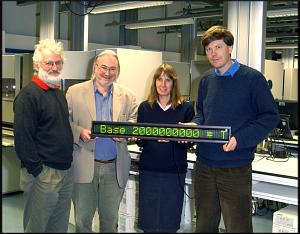Sanger's Celestial Spiral Staircase

The Wellcome Trust Sanger Institute has broken a genetic decoding record on its tenth anniversary which could literally take it out of this world.
The landmark completion of two billion letters of sequenced DNA will push biomedicine to a new level. It could also do that figuratively: if this DNA were scaled up to the size of a spiral staircase it would reach to the moon.
The steps on this biological stairway contain vital information about biology, health and disease in humans and other organisms. Genes – active parts of DNA code – can determine whether we are predisposed to succumb to a particular disease, how we respond to medicines and how severely microbes affect our health.
Since the Sanger Institute started a decade ago at Hinxton, Cambridgeshire, set up with funding from the Wellcome Trust biomedical research charity, its teams of international scientists have worked on an impressive list of sequencing projects. Today, nearly 700 staff contribute to the Institute’s research.
Apart from contributing one-third of the work involved in deciphering the human genome they have also helped crack the DNA secrets of more than 25 microbes that cause some of the world’s deadliest diseases, including malaria, TB, typhoid and plague, which claim millions of lives every year.
Other species which have been decoded are model organisms, such as the nematode worm and yeast, used to understand human biology and disease.
“The work carried out here has forever changed the way science works. Our understanding of organisms has been pushed forward light years.
“In just ten years the Sanger Institute has developed from a group of less than twenty scientists working in converted labs to the world leader in finished sequencing material. It really is a remarkable achievement and I’m proud to be part it.”
Dr. Jane Rogers Head of Sequencing at the Wellcome Trust Sanger Institute
As well as generating the DNA sequences, the Sanger Institute analyses them to find genes. This detail, the analysis and the software are made freely available to researchers around the world on the principle that it is the fastest and most efficient way to achieve biomedical advance.
“The founding of the Sanger Centre was a risky gamble. Thanks to the dedicated efforts of everyone here, to our international collaborators, and to our funders’ faith in us, the gamble became reality. I don’t think any of us could have thought we would have come so far, so fast. Now the challenge for the world is to use these sequences wisely and equitably – for the advancement of knowledge and for the universal human good.”
Sir John Sulston Founder Director of The Wellcome Trust Sanger Institute
“We have sequenced a phenomenal amount of material but just as importantly we have ensured that the standards of accuracy are unsurpassed – far above internationally accepted measures.
“The 15-fold increase in traffic to our website in the last couple of years indicates that we must be getting things right and that we are making a big contribution to understanding how devastating diseases work.”
Professor Allan Bradley Director of The Wellcome Trust Sanger Institute
“This latest milestone for the Sanger Institute is another dramatic achievement by a talented and dedicated team of world-class sequencers. Our hats are off to our colleagues.”
Dr Francis Collins Director of the National Human Genome Research Institute, Bethesda, USA
More information
History of two billion bases

- The first DNA clone to be submitted to the databases from the new Sanger Institute in 1993 ‘began’ with the base G. The two billionth base, from mouse chromosome 2, was a T. [Statistics]
- The number of Sanger staff has grown from 17 at the inception of the Institute to 695 today.
- The two billion base-pairs is composed of: human, 903,000,000; mouse, 630,000,000; zebrafish, 246,000,000; C. elegans, 48,733,454; yeasts, 12,955,526 plus more than 25 genomes of pathogens (see below)
- Among the pathogen genomes sequenced are those that cause: malaria (3,000,000 deaths p.a.); whooping cough (280,000 deaths p.a.); TB (2,000,000 deaths p.a.); typhoid (600000 deaths p.a.)
- The Sanger Institute’s researchers have published 100 reports in journals published by Nature and Science.
The Wellcome Trust and Its Founder
The Wellcome Trust is the most diverse biomedical research charity in the world, spending about £450 million every year both in the UK and internationally to support and promote research that will improve the health of humans and animals. The Trust was established under the will of Sir Henry Wellcome, and is funded from a private endowment, which is managed with long-term stability and growth in mind.


